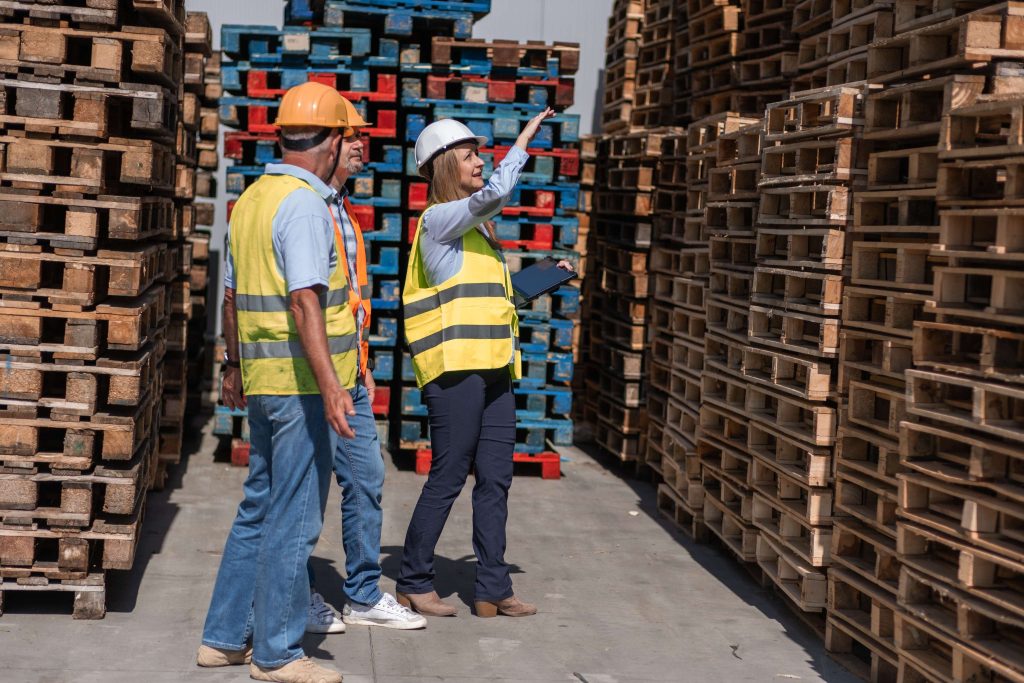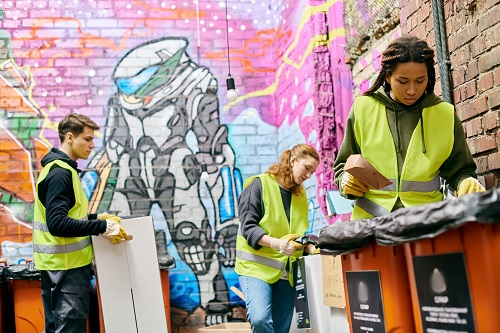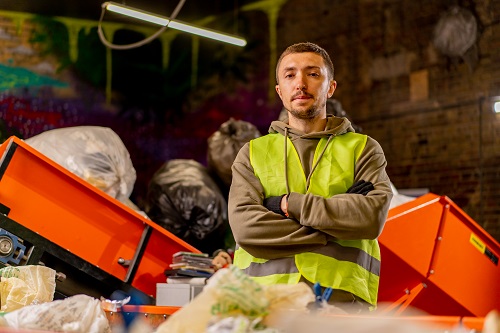Pallet Removal
Pallet removal refers to the process of removing damaged or utilized wooden or plastic pallets at a location for either secure storage, recycling, or disposal. Most warehouses, stores, and factories use pallets to transport goods, and they pile up rapidly.Clearing work areas of empty pallets reduces clutter, eliminates hazards, and creates space for day-to-day operations. If you want to find out about safe, fast ways to dispose of additional pallets, continue reading the following sections.
GET A FREE ESTIMATE
What will it cost for us to remove your junk and take it to a disposal site? We would love to provide you with an approximation of the final price. All you have to do is give us some information about the cleanout or demolition project you have in mind. Please fill out the nearby form.
The Unseen Impact
Pallet removal designs not only affect warehouse floors; they design ecosystems, business prices, and even global trade. Pallets may be rudimentary shipping implements, but their life and death extend well past logistics, impacting forests, communities, and the reputations of companies. PPE waste and invasive insects have increased the importance of sustainable pallet practices for businesses and society.

Environmental Stewardship
Mindful pallet disposal retains resources and protects forests from exploitation. Recycling and repurposing pallets lowers the need for new timber, which is crucial when millions of pallets are landfilled annually. This waste isn’t just consuming space; it can transport invasive insects such as the emerald ash borer and the Asian longhorned beetle, which are responsible for widespread tree loss and billions in environmental damage.
Even companies that participate in local recycling programs or implement closed-loop pallet programs are aiding community initiatives and curbing deforestation as the emerald ash borer wipes out virtually all ash species in North America.
Economic Advantages
When businesses recycle or up-cycle pallets, they save waste hauling and landfill costs. They discover what hidden value there might be in selling surplus or damaged pallets to recyclers, or repurposing old lumber into mulch or furniture. Partnering with pallet recycling firms often saves on waste management and can free warehouse space, thereby reducing overhead.
The cost benefits are clear: less waste means fewer disposal costs, and better pallet management can even open new business opportunities. Many companies are experiencing the hidden benefit of increasing their bottom line by controlling pallets more effectively. Simplified shipping leads to fewer lost pallets and less new buying, which has an immediate effect on the bottom line.
Operational Efficiency
Properly executed, pallet removal will make your warehouse operations more efficient. Fast clearance and frequent pickups maintain open room, reducing tripping hazards and preserving aisles for employees and equipment. Inventory with tech is tracking pallet flows, so companies know when to arrange pickups or fixes.
This avoids mess, promotes security, and enhances general efficiency, rendering daily work easier and quicker.
Corporate Responsibility
Companies demonstrate leadership by opting for sustainable pallets. They inspire employees and fellow companies, creating a culture of environmental stewardship. Participating in local recycling programs or hosting them can increase a firm’s reputation in the community.
Proper waste disposal, PPE, and even pallets demonstrate a moral fiber and a dedication to larger societal objectives.
Resource Conservation
Recycling pallets reduces consumption of new wood and aids in mitigating deforestation. Recycled pallets in supply chains, for example, are an obvious step toward sustainability. When companies purchase or manufacture new pallets, obtaining wood from certified forests reduces damage to the environment.
By reusing and repurposing pallets, we maximize the potential of each one, minimize the supply chain footprint, and preserve natural resources for years to come.
Removal Logistics
Efficient pallet removal logistics reduce warehouse problems, encourage safety, and bolster environmental initiatives. Regular, efficient removal schedules keep clean, accident-free facilities. Scheduled pickups prevent the accumulation of additional pallets, which may occupy valuable space and cause safety hazards.
Partnering directly with removals means we are able to accelerate pickup, minimize downtime, and ensure pallets are treated properly. We optimize loading on pickups to save space and fit more pallets per trip, reducing cost and emissions. Most importantly, sustainable disposal prevents pallets from taking up space in landfills and aids worldwide reforestation efforts.
Collection Methods
Curbside collection: Pallets placed at a designated area for pickup.
Scheduled pickups: Removal services collect pallets at set times and reduce clutter.
Drop-off centers: Businesses transport pallets to local recycling points.
On-demand collections: Requests are made as needed for flexible removal.
Bulk removal: Large quantities cleared out by specialized teams.
Wanted: Remove tracking requests is the secret to a seamless process. Implement a process to record when and where every pickup is necessary. This assists firms in reacting more rapidly and scheduling routes more effectively.
A list of local pallet removal services makes scheduling straightforward. For instance, all cities have recycling centers or independent companies that deal in pallet pickup. This enables companies to shop around and select the provider that suits them best.
Safety Protocols
Dealing with wooden pallets must have very rigid safety guidelines. Pallets are heavy and cumbersome, so there’s an inherent risk of injury, particularly back strain, if you lift them incorrectly. I train my staff on ergonomic lifting and stacking methods.
We all know to check for loose nails, splinters, or cracked boards prior to moving a pallet. Compliance with national and local safety regulations translates to wearing gloves, steel-toed shoes, and occasionally even eye protection.
Broken or dangerous pallets should be segregated and managed carefully to prevent incidents or environmental hazards. Conducting safety audits, once they become routine, maintains a high standard and helps foster a safer work environment for everyone.
Technological Integration
Tech even plays a big role in pallet removal. Most companies have software that tracks pallet inventory and schedules pickups, which keeps records up to date and turnaround times quite short.
Mobile apps that connect businesses with removal services could make it easy to request pickups, confirm schedules, and communicate changes. They dispatch reminders, so missed pickups occur much less.
Data analytics assist in identifying patterns, such as which seasons generate the highest waste or which collection paths save the most time and gas. With this data, enterprises can plan more intelligently, save money, and lower their carbon emissions.
Pallet Afterlife
Wood pallets are an integral part of shipping and warehousing worldwide. Over 90% of all pallets are wooden, and nearly 2 million are in use in the U.S. Daily. After their first use, pallets can follow several paths: they can be reused, recycled, or repurposed. Any one of these options helps reduce waste and promotes a more circular economy.
A good pallet management plan covers the three pillars of zero waste: reduce, reuse, and recycle. For customers and individuals, understanding a pallet’s afterlife is not about disposal—it’s about viewing materials as precious and sustainable.
Reuse
Pallet afterlife is easy! Wooden pallets, loved for their strength and low price, can often be fixed and reused dozens of times before they’re spent. Several companies maintain economical practices by turning pallets for delivery and storage, reusing the same units for a handful of trips.
Commercial establishments can donate pallets that are in good condition. Donate usable pallets to support groups, schools or small shops. Here are some options for donation:
Community gardens that need raised beds or compost bins
Nonprofits building temporary structures
Schools for storage or craft projects
Local artists using raw materials
Small businesses with limited shipping budgets
By extending the pallet lifecycle, enterprises save money and decrease landfill waste in their supply chains, making them leaner and greener.
Recycle
When pallets can no longer be reused, recycling is next. Recycling begins with sorting—wood, plastic, and metal pallets must be segregated. Wood pallets get chipped into mulch, pressed into particleboard or ground for animal bedding.
Here’s what to do with them: Pallet Afterlife. Many local recycling centers and even some trash companies take old pallets. Bigger cities might have dedicated pallet recyclers that can deconstruct and handle the materials in a secure manner.
Re-using pallets has an actual effect. Recycling saves approximately 43 million trees annually, as 350 million pallets are recycled or reused rather than landfilled. Wood pallets are 100% recyclable, so there’s no reason for them to be trash.
For businesses, hopping onto recycling programs is more than just an image. It’s cost-saving and satisfies sustainability objectives.
Repurpose
Pallet Afterlife, a fresh mission for old pallets. A lot of people make their own coffee tables, benches, or bookshelves out of pallet wood. Gardeners construct compost bins or planters. Companies can even sell these upcycled items, branding them as environmentally responsible and attracting waste-conscious consumers.
Some even make pallets into art, such as murals, signage, and art. Re-purposing ain’t just for the big boys. All of us can experiment with small projects at home.
From wall decor and simple shelves, pallets have an afterlife as stylish repurposed goods. This ingenious concept transforms the ordinary shipping pallet into a one-of-a-kind keepsake.
Common Hurdles
Pallet removal presents businesses with a combination of technical, economic, and logistical challenges. These challenges stem from the way pallets are stored, transported, inspected, and handled in bulk. All steps require detailed planning, as resource and space squandering are no-no’s.
Storage
Warehouses have a hard time dealing with used pallets, particularly in areas with limited space and a constantly changing materials flow. Stacking pallets smartly can save room but can lead to breakage if you’re not careful. Protecting pallets from moisture and extreme temperatures by keeping them dry and away from the elements inhibits rapid decay and prevents plastic from becoming brittle.
Marking zones and installing racks or shelving makes it simpler to locate and move pallets, reducing the chances of jams or confusion. For high-turnover businesses, additional on-site storage or an off-site solution may be a viable option to prevent clutter.
Transportation
Getting pallets out of the warehouse is usually a pain. Fuel and route planning are significant considerations, particularly if pickup locations are disperse or traffic is variable. Route software plans faster trips and reduces wasted fuel.
Working with removal companies who plan regular pickups helps keep things on track and avoids backups. For heavy shipments, utilizing flatbed trailers or large trucks is essential and results in greater fixed expenses and increased logistical demands to maximize load per vehicle.
Condition
Pallet condition is a must – check before making a call. Good wood or plastic pallets can be reused, but the broken ones may be only suitable for recycling or, in the worst case, landfill. Wood pallets are tough to sort because they differ greatly in quality and damaged ones create risks during handling.
For plastic pallets, sorting may utilize conveyor belts and sensors, with emerging technologies such as Near-Infrared (NIR) aiding in identifying various plastics. Black colorants that reflect NIR light can enhance sorting. Composite plastics are difficult to recycle and frequently simply downcycled or landfilled, feeding into worldwide waste.
Every broken pallet not only increases your disposal fees, but it impedes warehouse operations and creates safety hazards.
Volume
There are challenges to working with massive numbers of pallets. High volumes can swamp storage and removal systems, making them difficult to keep up with. Scaling out removals, such as bulk pickups or scheduled collections, keeps it manageable.
The heavier the burden, the higher the disposal fee, particularly if separation and recycling are required. Many companies have to weigh the cost of recycling versus making new pallets. Recycling plastic pallets, which can save up to 60% in emissions, might not actually be cheaper.
Bulk pickups are helpful but require close coordination to avoid additional fees or delays.
Financial Realities
Pallet removal adds cost and revenue layers that dictate business choices. For some, pallet management is more than shifting wood or plastic platforms; it’s a financial reality. Companies must evaluate more than just the service fees, including concealed costs and unexplored revenue recovery potential.
A comparison of providers reveals large cost variances. A tiny local recycler might give you a lower pickup, but bigger companies can provide volume or package deals. Factors such as how many pallets you’re moving a month, your city’s rates, and whether sorting is required all factor into cost.
Downtowns have higher disposal costs due to demand and logistics. Budgeting for these expenses is crucial. For businesses consuming thousands of pallets per month, even a minor fee adjustment has a major effect. Some ignore these figures. They accumulate quickly and can tip the bottom line.
For instance, one company saved $100,000 that year alone by recycling rather than landfilling pallets. With the right partners in place, companies can transform what is perceived as waste into a reliable income stream. Others have even created new revenue streams from upcycling or selling into creative industries.
Hidden Expenses
Surprise expenses can sting. Illegal dumping can result in fines, particularly if local regulations are stringent. A few areas demand recycling accountability, and businesses deemed out of compliance can be slapped with fines that amount to tens of millions in extreme situations.Storage fees seem insignificant. However, they devour profits, particularly if pallets start to accumulate. When owners recover pallets following storage, recyclers or junk dealers sometimes charge fees for storing them, which may be at least 20% as high as new pallets.Improperly dealing with pallets can bog down warehouse processes, encumber labor and increase costs. Smart budgeting is accounting not only for the straightforward expenses, but these hidden ones. It keeps surprises away and companies in control of their pallet strategy.
The Circular Model
The circular model for pallet removal hopes to disrupt this tired, linear use-and-dump cycle. It prioritizes maintaining the utility of products and materials during their extended use. It reduces waste, conserves resources, and minimizes the ecological damage of industrial processes.
In the pallet industry, it led to novel approaches to handling, recycling and designing pallets to conform to a more circular cycle.
Closed-Loop Systems
Closed-loop systems are designed so that pallets get returned, repaired, reused, or recycled instead of trashed after their original use. This maintains materials in the supply chain and reduces the demand for virgin resources.
For instance, across numerous international retailers, pallets are retrieved post-deliveries, inspected for damage, repaired as necessary, and recirculated. This rotation can occur tens of times before a pallet is ultimately not viable.
While a few top logistics players have enjoyed genuine success with such systems, they employ pooling models in which pallets are pooled among dozens of users, tracked, and serviced to extend their life span as much as possible. When pallets are no longer serviceable, materials such as wood or plastic are recycled into new pallets or different items.
The primary ecological advantage is the significant reduction in waste. Not as many pallets wind up in landfills, and less energy and raw material is expended creating new ones. This mitigates pollution and CO2 from production and disposal.
The Circular Model goes full circle when makers, users, and recyclers collaborate. Working together implies that pallets are monitored, quality is maintained, and losses are minimal. That creates a model that is circular and effective.
Material Innovation
New materials have transformed the design and application of pallets. High-strength plastics, composites, and wood from certified sources have extended the life and reusability of pallets.
Plastic pallets, for example, can endure a 15-year lifetime of unrepaired use, unlike conventional wood pallets. Eco-friendly materials reduce reliance on finite resources and save forests from destruction.
New designs use less material without losing strength. Research dollars go to seeking better alternatives from biodegradable plastics to recycled fibers to make pallets with an even smaller environmental footprint.
Companies that experiment with materials typically discover that they end up saving money. Less fixing and swapping out, less shipping, and even better hygiene make these steps worth it. As more companies experiment, the industry as a whole shifts toward a more circular, less wasteful system.
Policy Influence
Policies really dictate a lot of what happens to pallets — how they are manufactured, utilized and disposed. Regulations that promote recycling, safe processing of used pallets, or limiting landfill all help build the circular model.
Government standards may establish basic recycling quotas or provide credits for businesses that incorporate recycled content. When companies participate in policy discussions, they can advocate for reforms that simplify and reduce the cost of recycling.
This could include improved collection systems or tax incentives for repurposing. These transformations assist the entire sector in minimizing its footprint on woods, lowering water contamination, and decreasing environmental modification.
Policy changes don’t only assist firms. They further shield workers and nearby communities by ensuring resources are used efficiently and waste is handled responsibly.
Because two-thirds of wood packaging is pallets, even minor policy changes can help steer the entire industry toward greener solutions.
Conclusion
To get stacked pallets out of the way, clever gestures reward. Schedule every trip from pick-up to drop-off and monitor your savings. Get the most out of your pallets by reusing, recycling, or selling. Every option crafts less trash and delivers tangible benefits to your environment, your wallet, and the universe. Look out for location-variant regulations and be familiar with your purchasers or collaborators. Minor tweaks such as speedier sorting or improved connections with regional recyclers can result in major victories. Stay on top of new patterns like digital tags or reuse circles. To improve, meet others in your industry, hit the books, and exchange tips. Discuss what works and act to ensure pallets circulate in a positive loop.
Pallet Removal SERVICES
Let the JUNKWISELY team take the stress out of your Pallet Removal. We are dedicated to delivering not just a service, but a solution, allowing you to focus on what’s next. Experience the ease and satisfaction of a professionally handled cleanout by choosing JUNKWISELY.

UPFRONT PRICING
We don’t beat around the bush when it comes to junk removal prices. At the beginning of your appointment, we’ll be able to calculate the final cost of our services. That way, you’ll be able to know what you’ll owe us from the start. Why wait until later?

PROFESSIONAL SERVICE
You’ll be glad that you chose JUNKWISELY because our crew delivers a truly professional image. It’s because of our clean uniforms, smiling faces, and good work ethic that we’ve been able to meet the needs of so many clients before you.

ATTENTION TO DETAIL
Not only will we Remove your appliance with ease, but we’ll also sweep up behind ourselves so that you don’t have to deal with whatever mess was hiding beneath it. We’ll do whatever it takes to ensure your complete satisfaction because you deserve it! .
SAVE $20 WHEN YOU
BOOK ONLINE
No need to delay your appointment. Schedule with us online, and you can save twenty dollars.

READY TO SERVE YOU
Whether you need us to get rid of a refrigerator, freezer, washing machine, or dryer, we’re ready to get to work. All you have to do is book an appointment. Use either of the buttons below to get in touch with us. We’re looking forward to meeting you!




